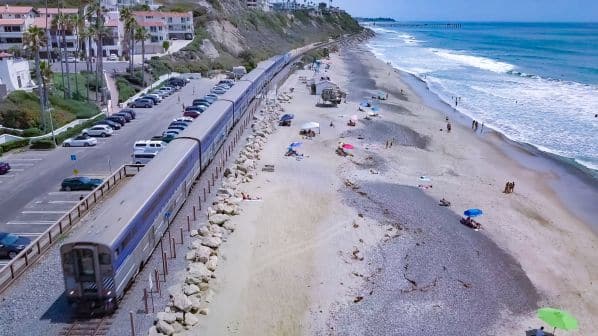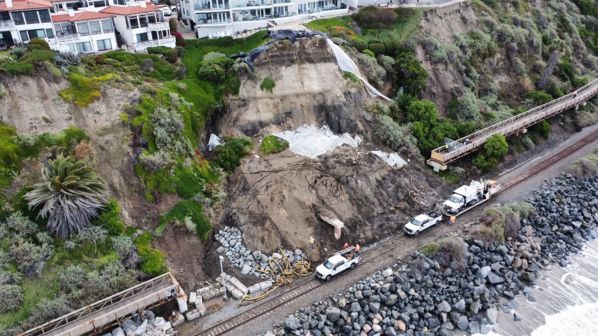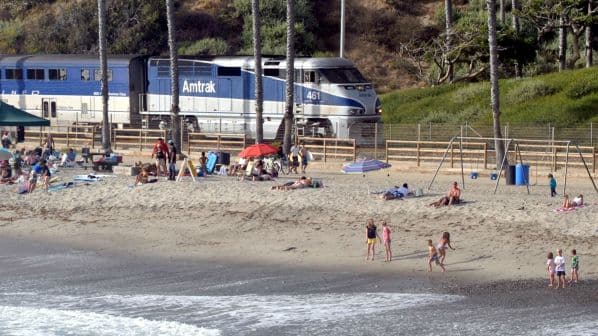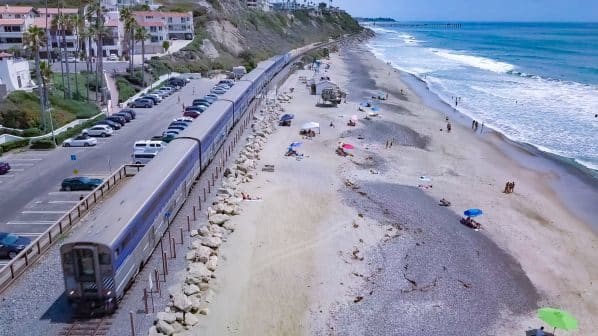BNSF suspended its overnight freight service on the coastal section of the 564km Los Angeles - San Diego - San Luis Obispo (Lossan) line in Orange County, California, on February 12. No trains are now operating on a section of the line in San Clemente north of San Diego due to damage caused by a landslide following prolonged heavy rain at the end of January.
Passenger services on the line are already suspended indefinitely after Amtrak and Metrolink halted operation on the section between Laguna Niguel/Mission Vejo and Oceanside on January 24. After an initial suspension, freight operations resumed but at a reduced maximum speed of 16km/h. However, freight trains are now deemed not to have sufficient clearance to make nightly trips through the emergency work area at Mariposa Point.
Lossan is the second-busiest passenger corridor in the United States after the Boston - New York - Washington, DC, Northeast Corridor (NEC). This is the fifth time in three years that hillside erosion has impacted operation on the coastal stretch of the line in Orange County. The line was closed for six months from October 2022 to April 2023 following damaged caused by Tropical Storm Kay and subsequent work to reinforce the hillside.
The State of California provided up to $US 10m in funds to the Orange County Transportation Authority (Octa) to support work to protect the railway under an official emergency declaration on February 2.
Work included improving water drainage from the hillside following alterations to topography. In addition, debris was removed from a trackside culvert inlet. Temporary tarpaulins were also installed to prevent further ground movement as heavy rains continued in the first week of February. These were gradually removed on February 8 with soil conditions described as “saturated.”
While debris was reported as continuing to fall into the right-of-way near Mariposa Point on February 7, the track remained “stable,” according to Octa, which enabled BNSF to resume operation at the reduced speed of 16km/h between 21.00 and 03.00. BNSF also inspected the track and deemed it safe to operate.
Teams have continued to monitor movement of the slope and the further movement of debris led to the decision to again suspend freight operations. These crews are currently assessing how much soil and debris would need to be removed to resume operation and whether removing soil from the toe of the slope could trigger further movement.
Octa and Metrolink’s project team is also reviewing a proposal from a contractor to design and build a barrier wall to protect the track.

Service disruptions
Metrolink services are currently only operating as far south as Laguna Niguel/Mission Vejo with no alternative transport to San Diego available. Amtrak operates 10 daily Pacific Surfliner services on the route, running between San Luis Obipso, Santa Barbara, Los Angeles and San Diego. Replacement buses are currently operating between Irvine and Oceanside.
The line carried 8.3 million passengers in fiscal year 2019, but continuing service disruption has resulted in ridership declining by more than half to 3.9 million trips in fiscal year 2023, based on projected fourth-quarter data. Some local politicians have since called for the construction of a multi-billion dollar alternative inland route to safeguard the railway’s future and offer a viable alternative to road journeys for the 14 million people living adjacent to the Lossan corridor.
Octa owns the 65km section of the Lossan corridor between Fullerton and San Clemente, including the 11km coastal section between Dana Point and San Clemente. Working alongside its subsidiary Lossan Rail Corridor, Octa commenced a study in November to assess the line’s existing and future environmental risks and the issues for operations and maintenance. The study will evaluate strategies to address these challenges and is due to be completed in autumn 2025.
“There is a crisis happening along this rail line and it hasn’t gotten the attention it deserves,” says California state senator, Ms Catherine Blakespear, chair of a Senate subcommittee looking at how to improve the line. “I don’t just want it to not fail. I want it to thrive.”



